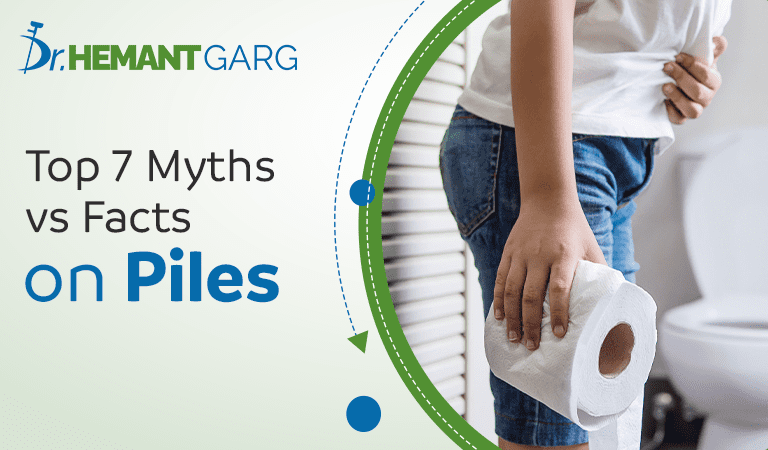
Top 7 Myths vs Facts related Piles | Clear all Piles-related Doubts
Fissures are technically different from piles or hemorrhoids, which are scientifically referred to as piles though commonly known in everyday parlance as swollen or protruding veins in the anal area. Although piles are ubiquitous, there are enough misconceptions related to them, which can stir up confusion and misunderstanding. However, it is worth focusing on seven myths and separating fiction from the facts in the Pinterest community.
Myth 1: I am among the rarest of people who developed piles.
Fact 1: First, hemorrhoids are prevalent. Indeed, they are one of the most frequent health ailments. It is estimated that as many as 50% of the world’s population will develop piles at some point in their lifetime. They are a consequence of pressure at the lower rectum, which, as earlier noted, may result from conditions such as chronic constipation, pregnancy, or sitting for lengthy periods. Because they are so common, having piles is far from being rare.
Myth 2: Piles is a condition that only develops in older adults.
Fact 2: Coming to piles, it is factual that it rises with age, still it is not confined only to older adults. Young adults and even adolescents can also develop piles, although they are at an increased risk of developing it if they are overweight, pregnant, or have chronic constipation. For instance, pregnant women are more prone to the formation of hemorrhoids because the pressure on the rectal veins is given by the uterus, which is constantly growing. The pile’s description shows that piles can happen to anyone, regardless of age.
Myth 3: piles treatment through a surgical procedure.
Fact 3: One can avoid piles surgery even if the piles do not respond to the above conservative measures. It is for this reason that a large number of patients want to use methods other than surgery. First-line interventions involve:
Such as changes in the patient’s diet and daily routine, including more fiber. They were sufficiently hydrating themselves and trying the products that can be purchased without a prescription. However, conservative methods, including rubber band ligation, sclerotherapy, and infrared coagulation, are mainly applied in chronic cases. Surgical treatment is mostly practiced when all other kinds of treatment have proven ineffective.
Myth 4: Foods like chilly pepper and cold water lead to piles.
Fact 4: Consuming spicy foods is not a significant culprit in forming piles, not being able to freeze them by touching cold surfaces. The leading causes of piles are based on the pressure in the rectal veins, and the leading causes are rigorist training, constipation, and sitting. Even if spicy foods are eaten, they may irritate piles, and if one sits on cold surfaces, one is bound to be uncomfortable, but these are not causes of piles. It should, however, be emphasized that what should be controlled is the different factors that lead to pressure buildup in the rectal region.
Myth 5: Exercises must be avoided if one has piles.
Fact 5: This, too, is a myth, as exercise is known to protect against the firmer piles and aid in managing the softer type. Physical activity aids in proper bowel movement and prevents one from being a prize for constipation and pressure on rectal veins. Low-impact exercises like walking, swimming, and other mild exercises that do not strain the muscles are advisable for this condition. However, high-impact exercises or lifting heavy loads can worsen the symptoms, so activities that do not apply much pressure on the abdomen should be taken.
Myth 6: With piles, a person is at a higher risk of getting cancer.
Fact six: Though many of them may have heaps, it does not in any way put them at risk of getting colon cancer. But, at the same time, some symptoms that are associated with piles still may signal other severe conditions like cancer. People who experience such complaints need to consult a healthcare provider to determine the different causes of the symptoms excluded. Nonetheless, piles are not a harbinger of cancer, but like any disease, early detection and diagnosis help control the situation.
Myth 7: Sitting continuously for longer periods doesn’t cause piles
Fact 7: Contrary to the optimism Wan has for her job and her career, it is a fact that sitting for long hours does lead to piles, among other health complications. Prolonged sitting puts pressure on the rectal veins, and the danger is that it can cause hemorrhoids or increase the frequency of hemorrhoids. This remains particularly the case with those people who exhibit lousy posture or sit down for prolonged periods without standing up. This risk can be minimized, and circulation can be enhanced if one has to make it a point to stand, take a break, and stretch now and then.
Conclusion
Getting acquainted with the facts about piles will contribute to diversifying ideas and effectively administering the condition. Hemorrhoids or piles are relatively widespread and are treatable. However, the treatment entails distinguishing between myths and facts to ensure correct choices. Dr. Hemant Garg is the most reputed piles treatment in Jaipur and has years of work experience and is the Best Piles Doctor in Jaipur for Fissure Surgery and for such as Fistula surgery and Piles Surgery.